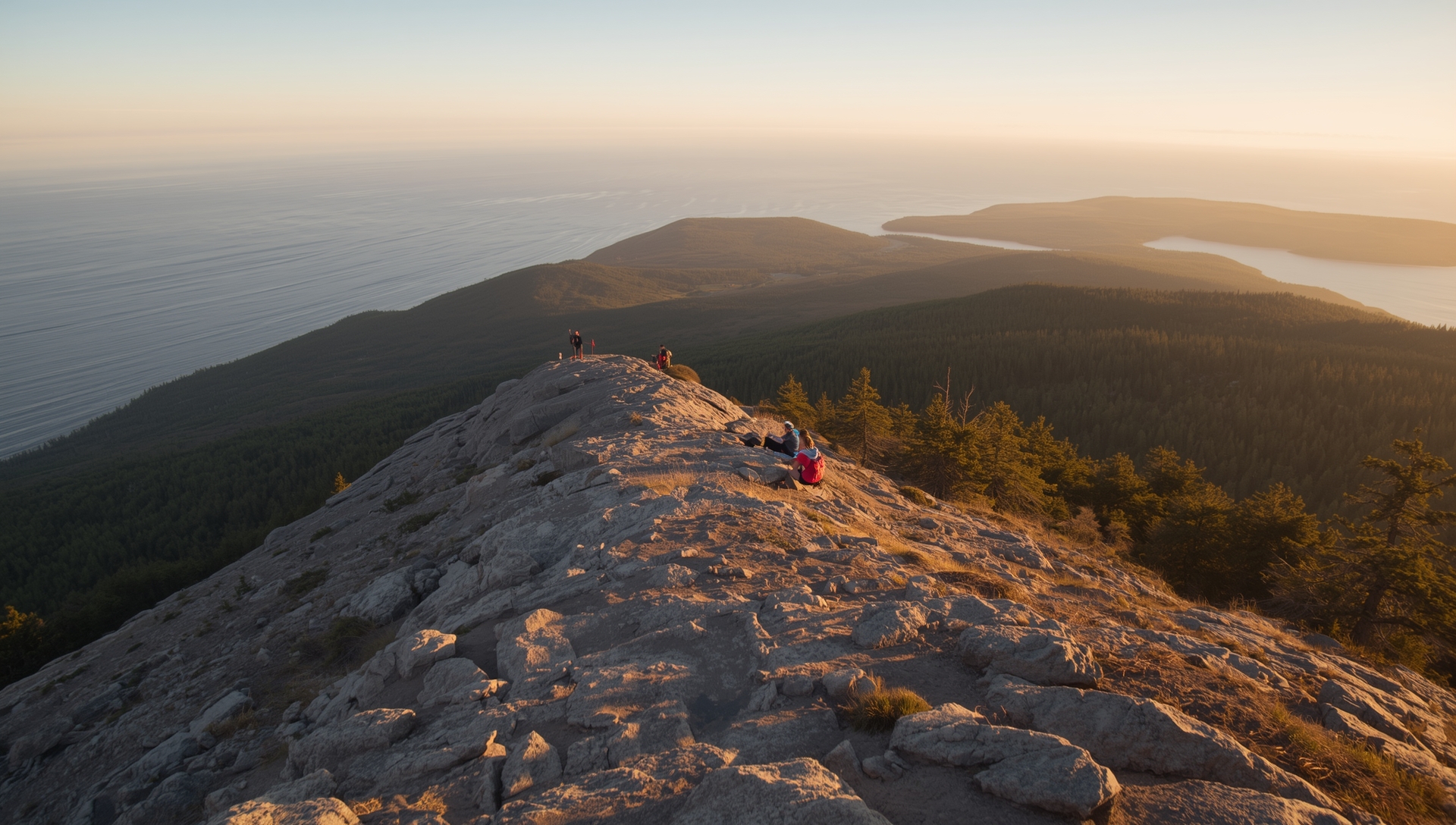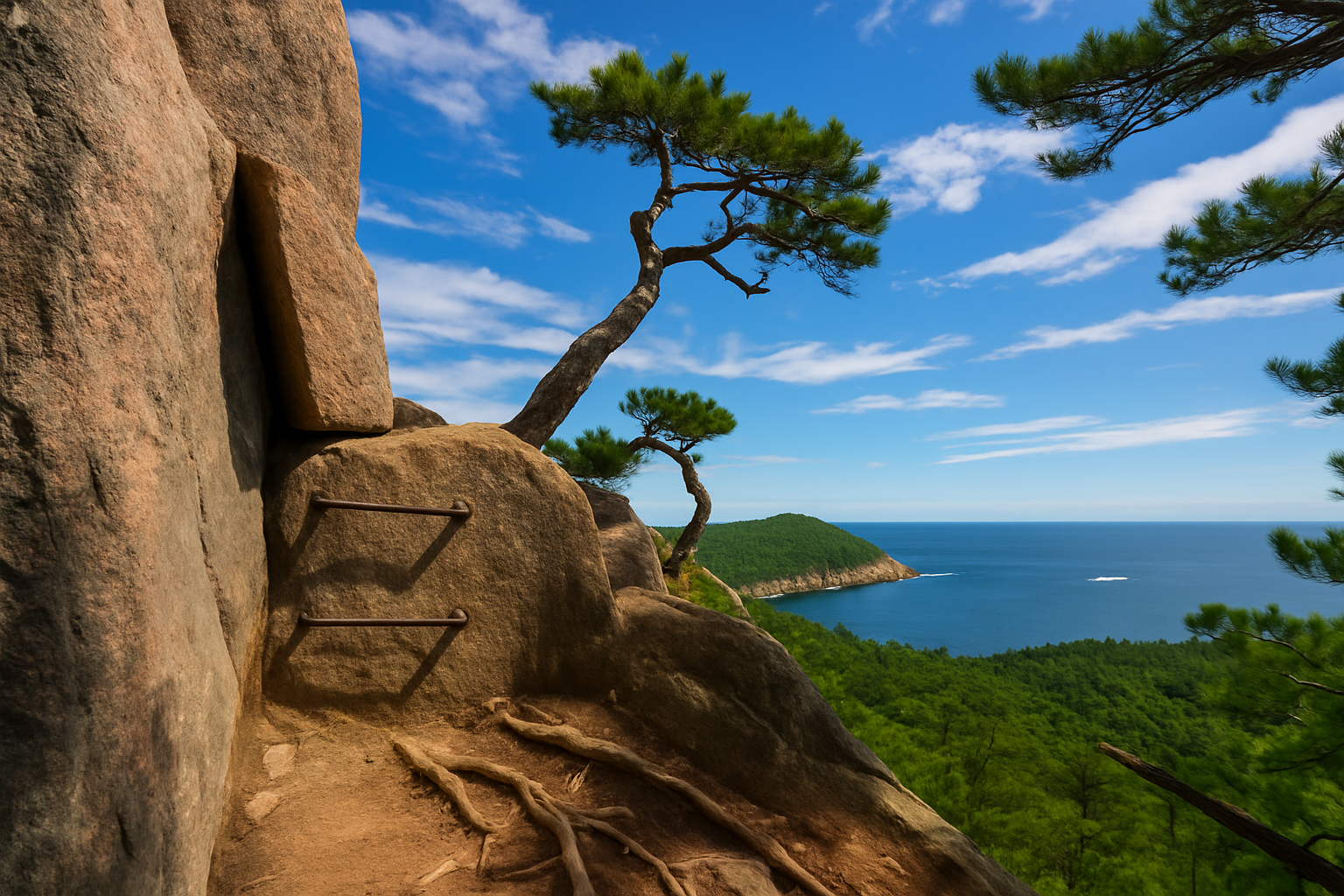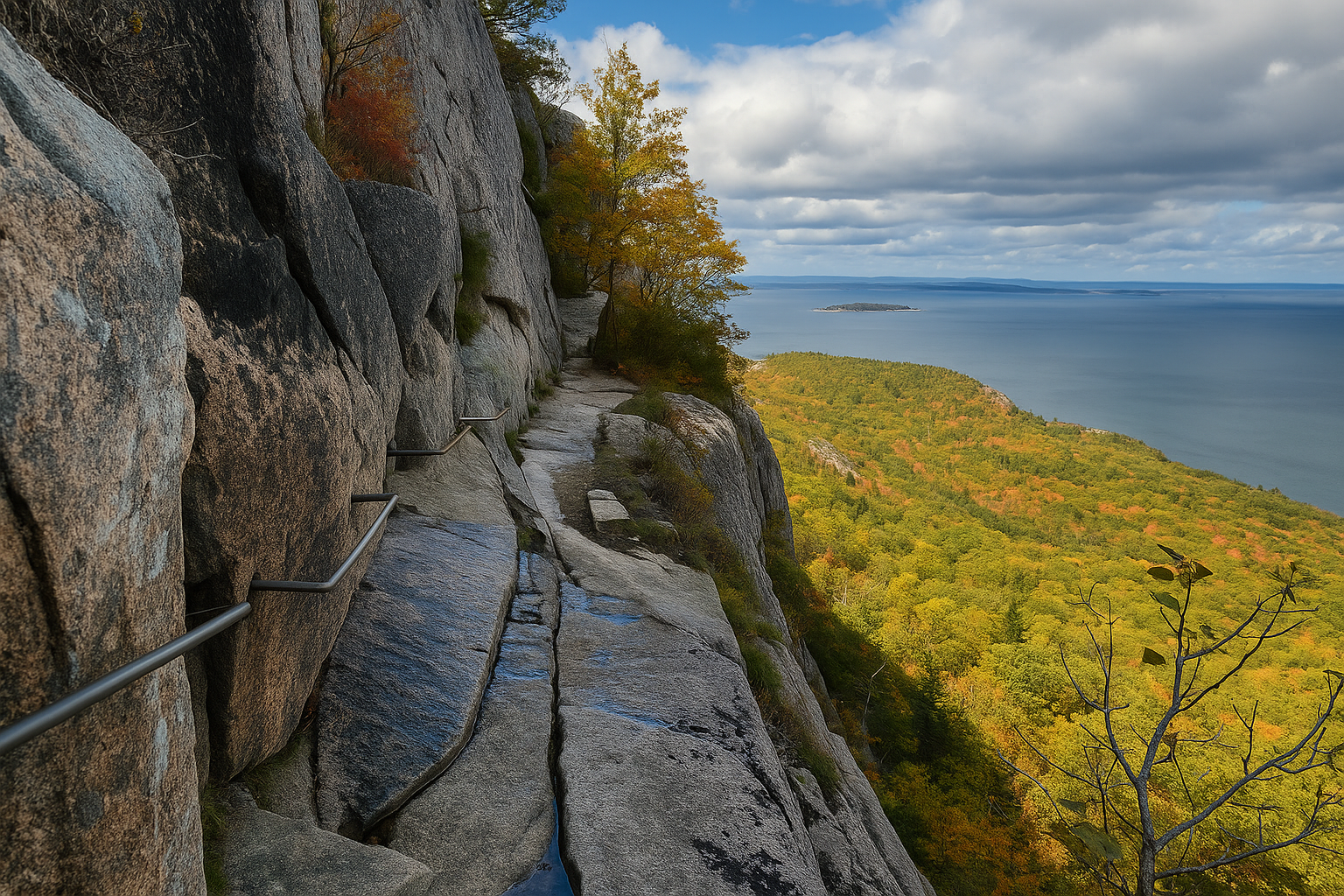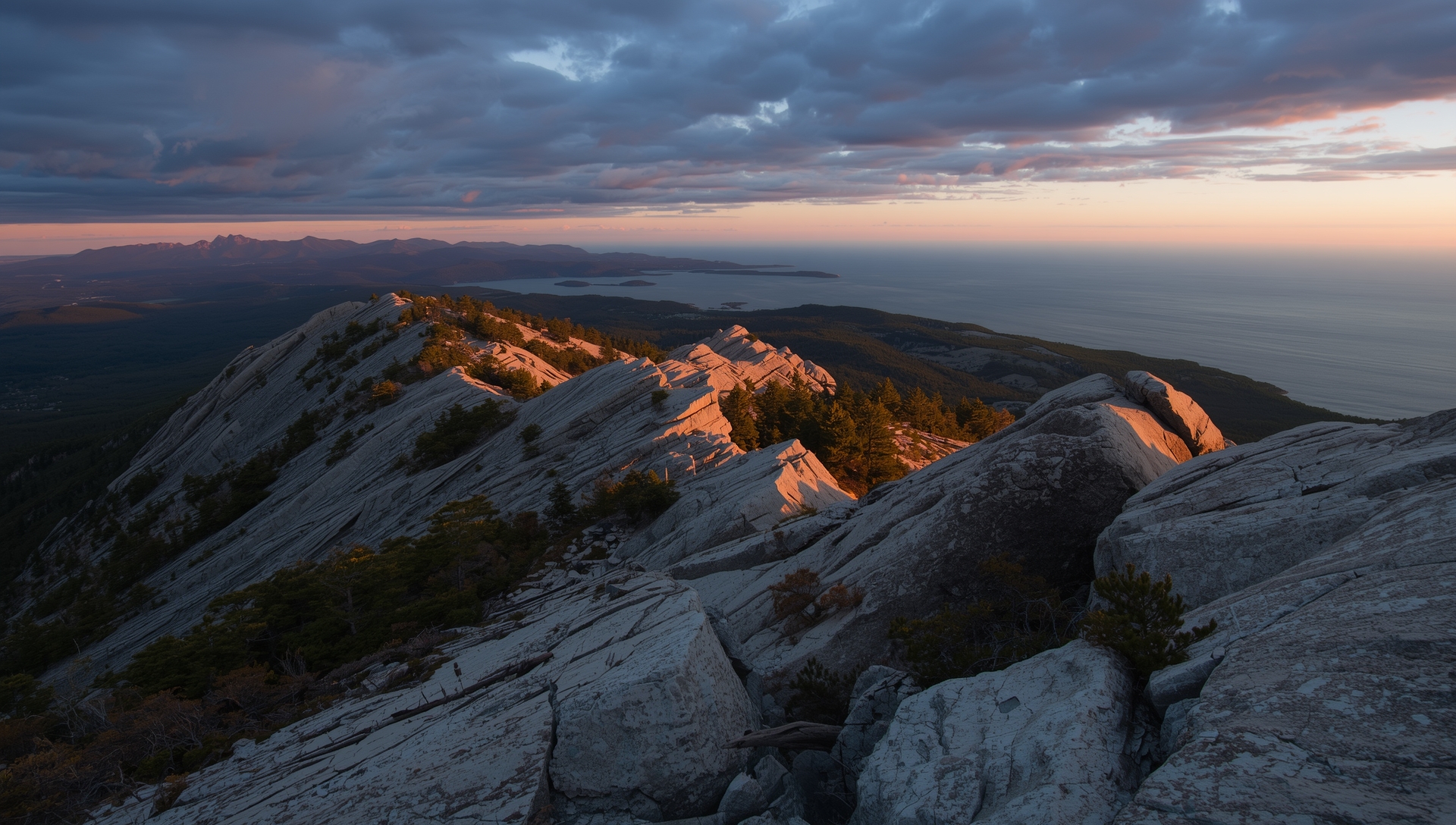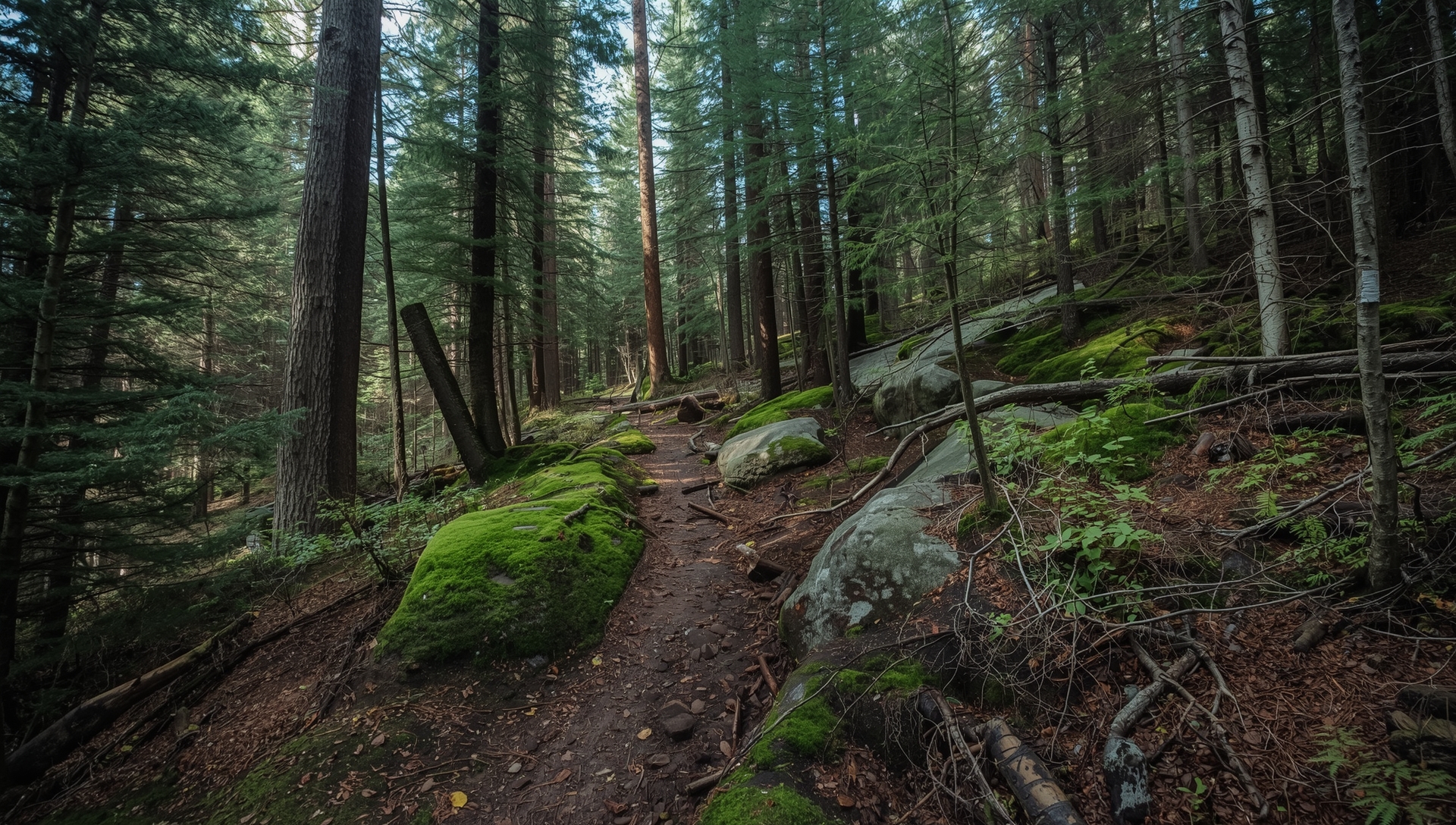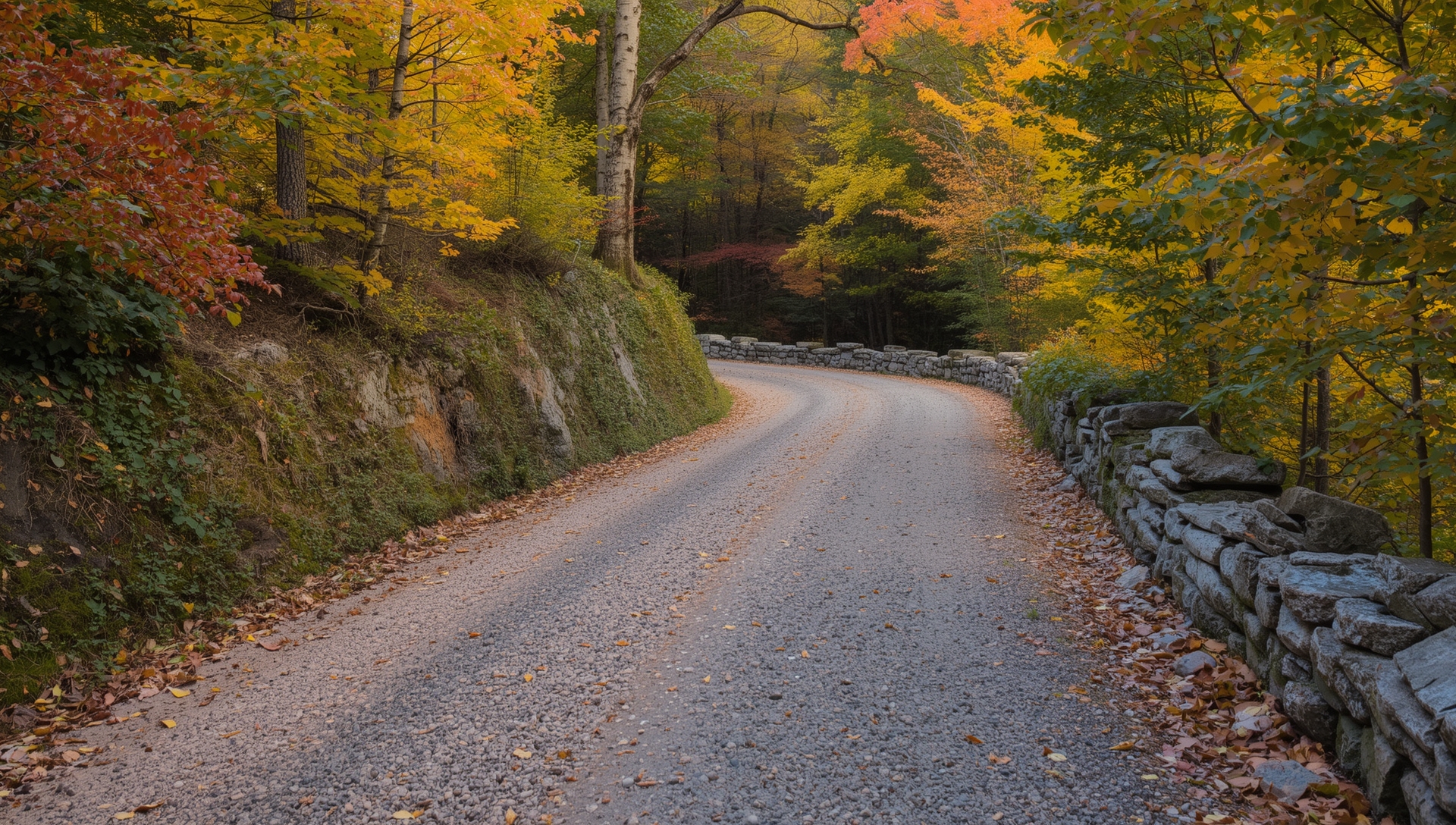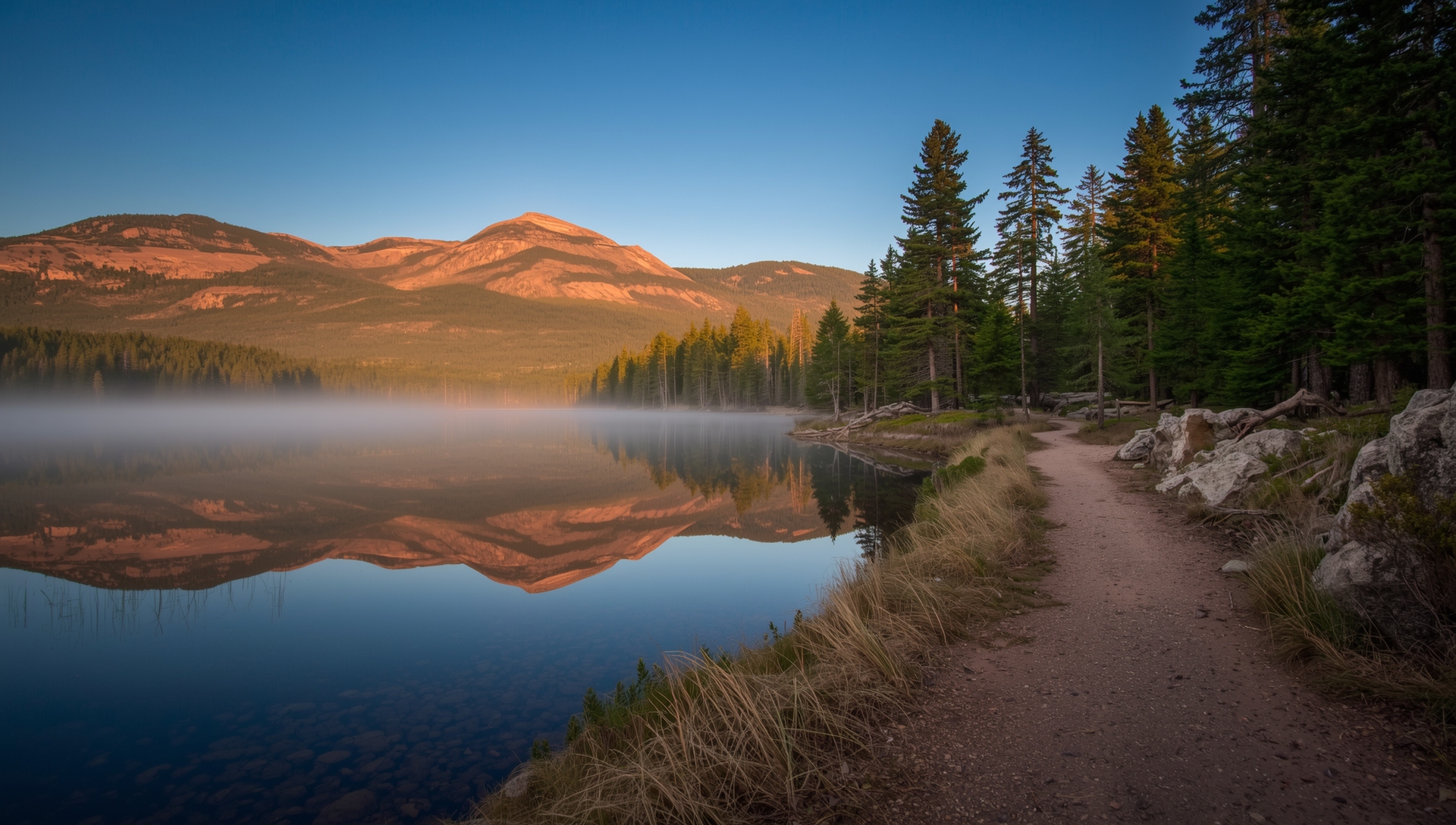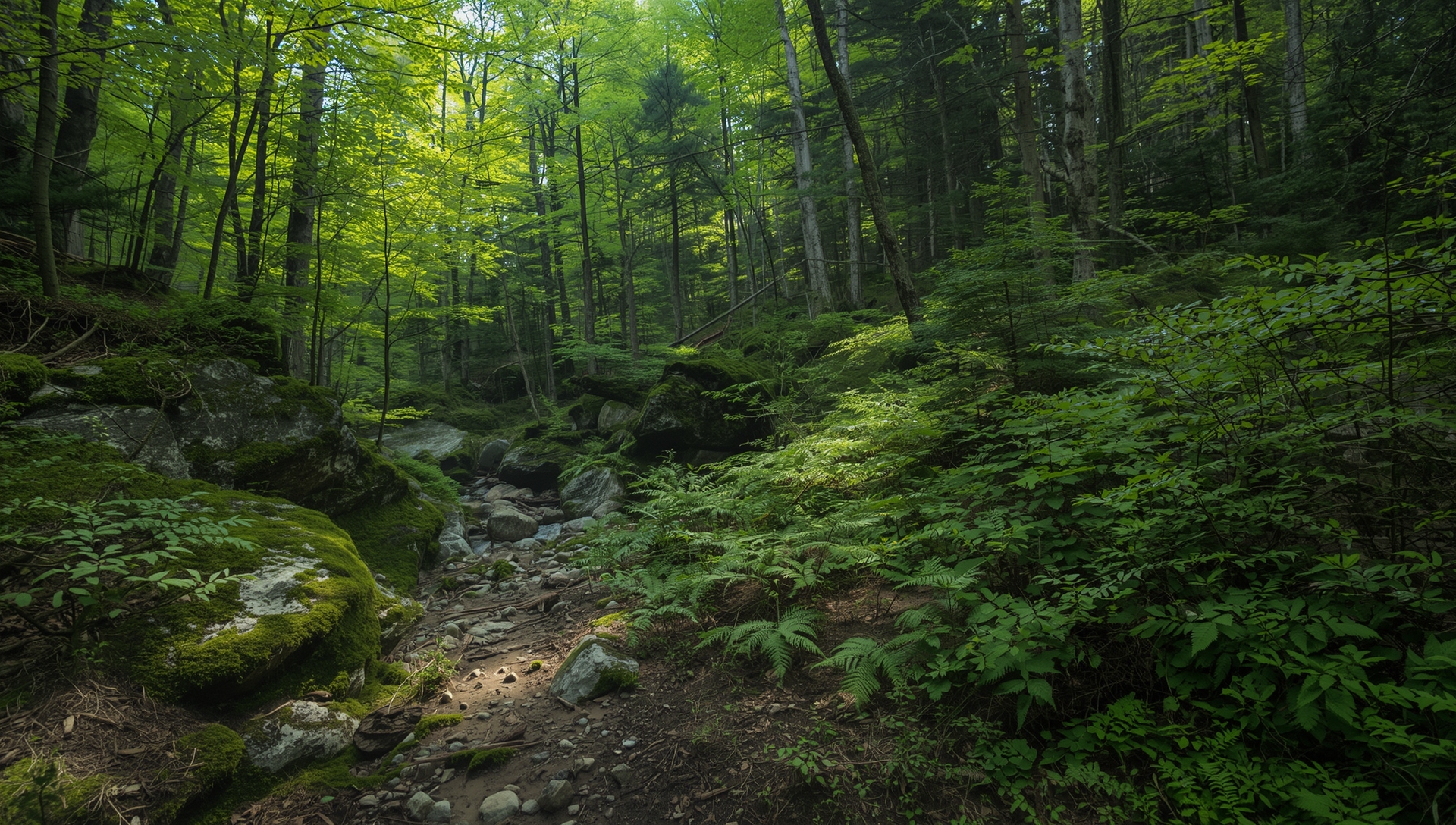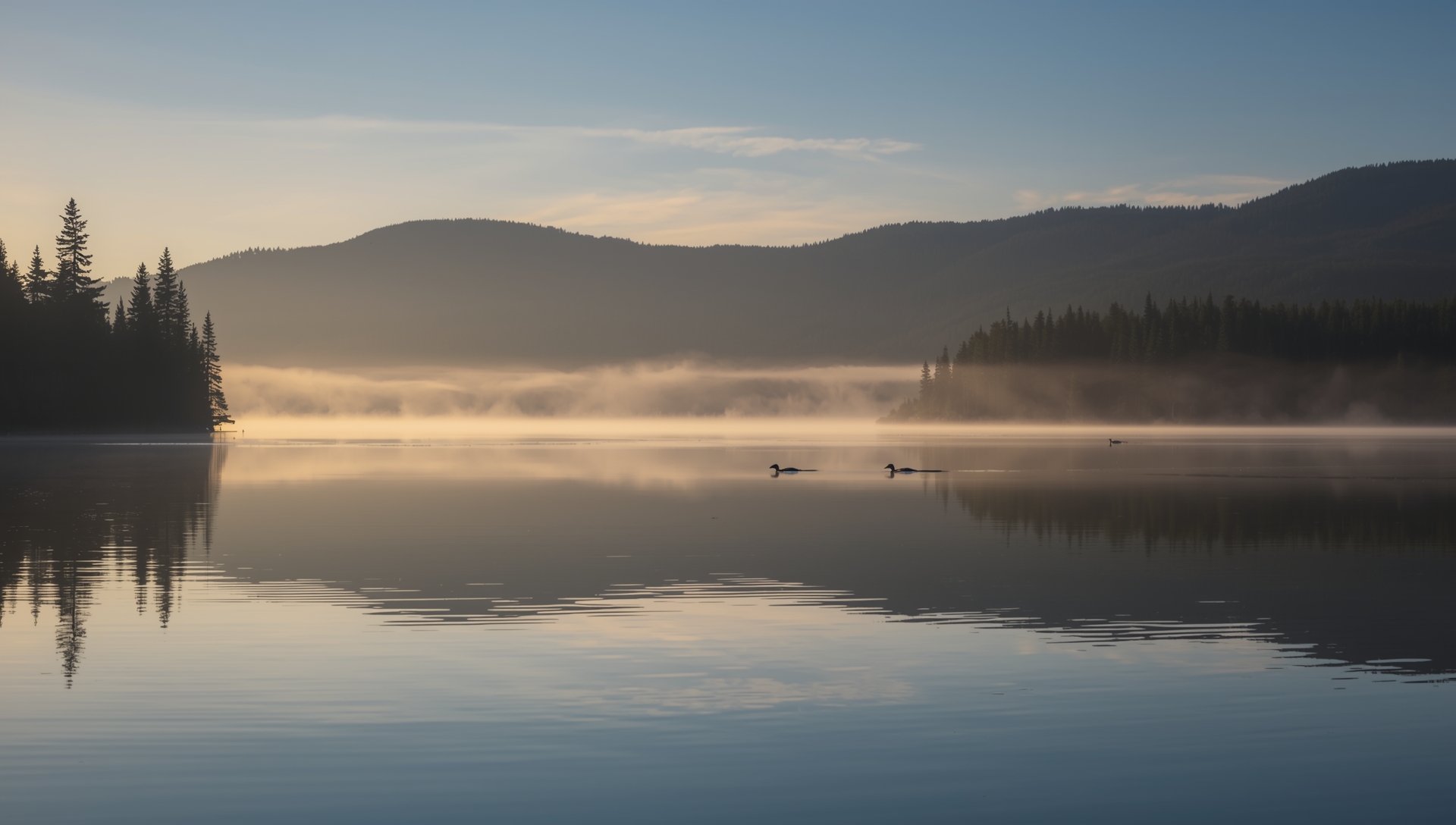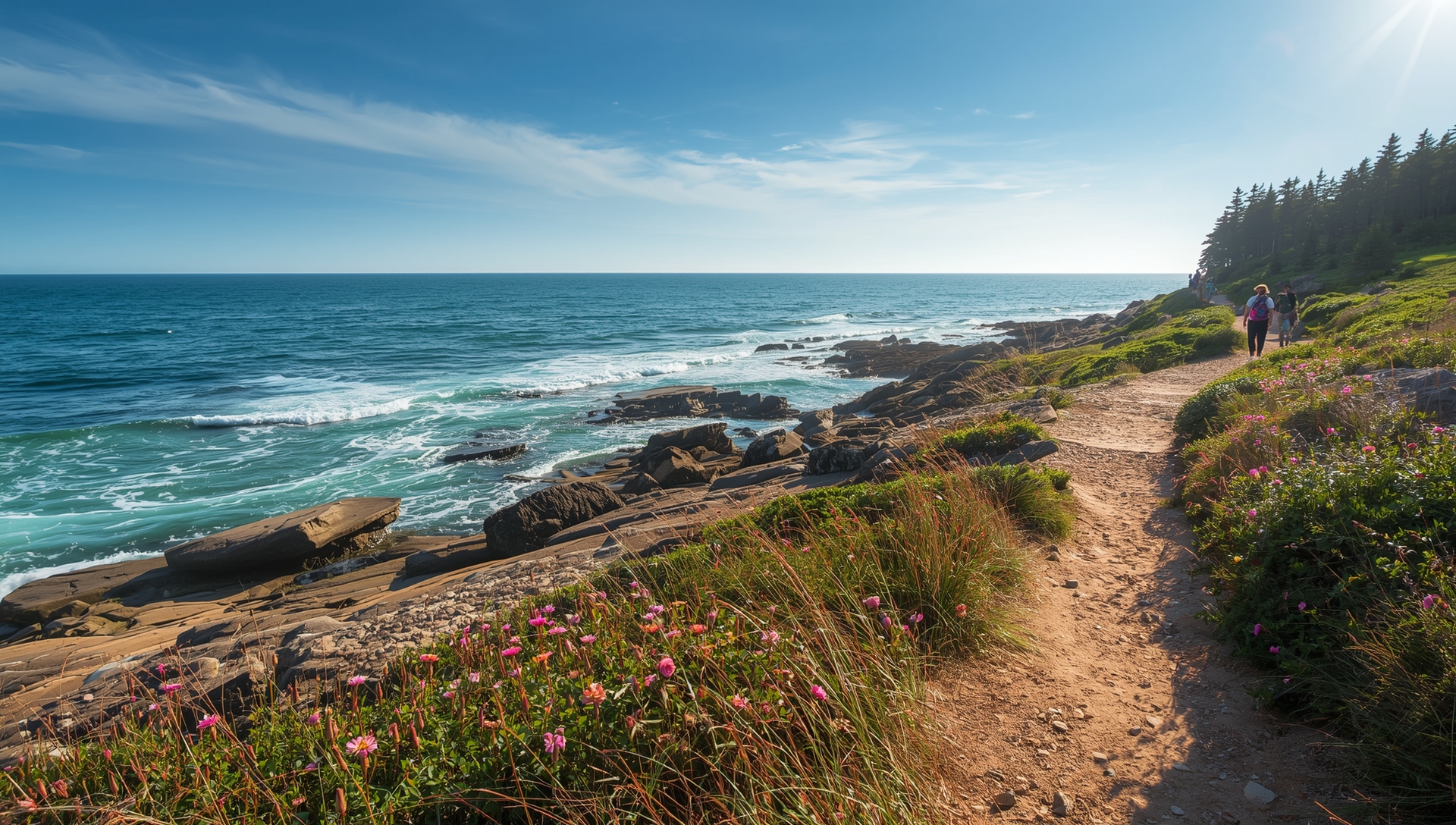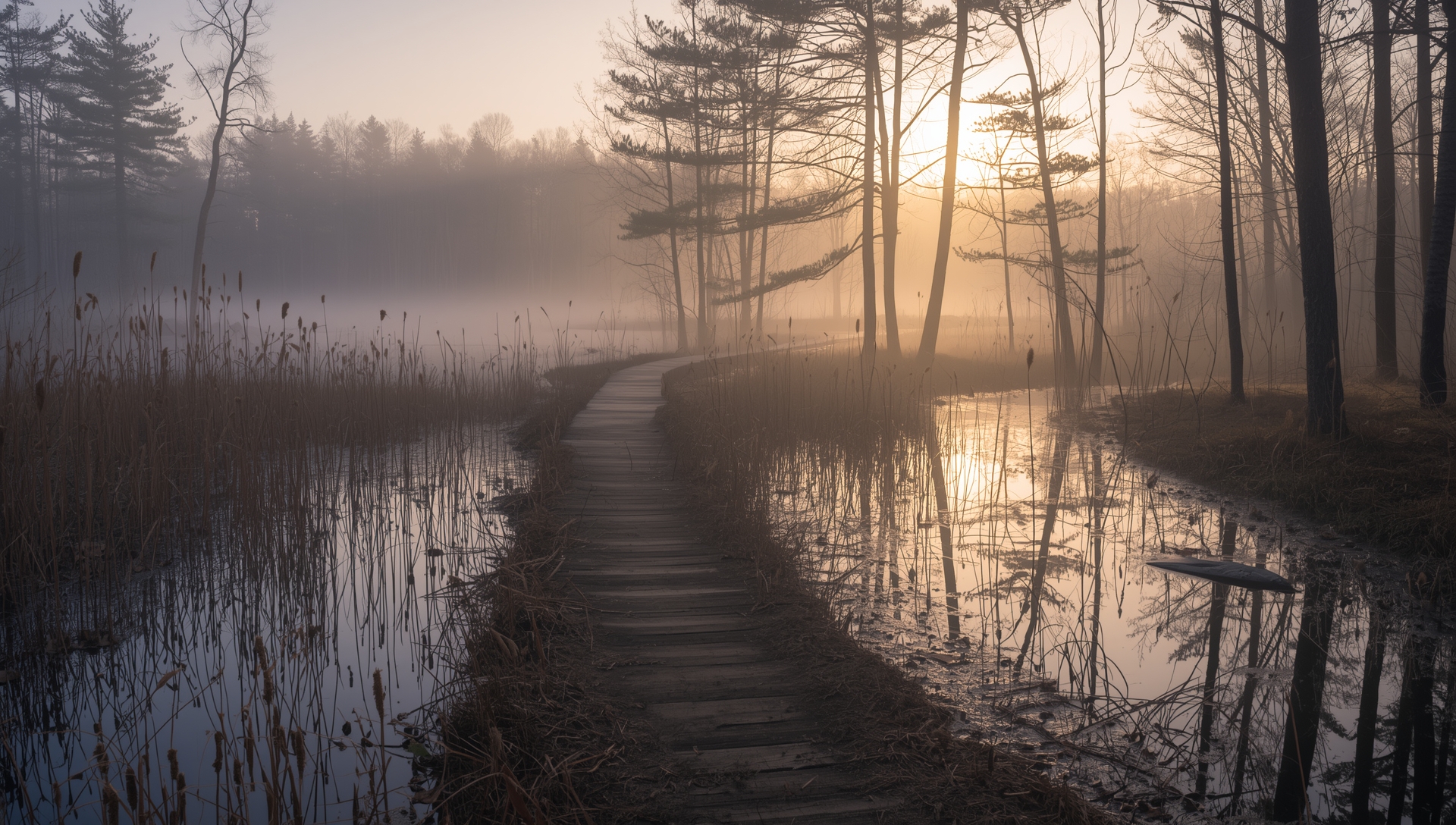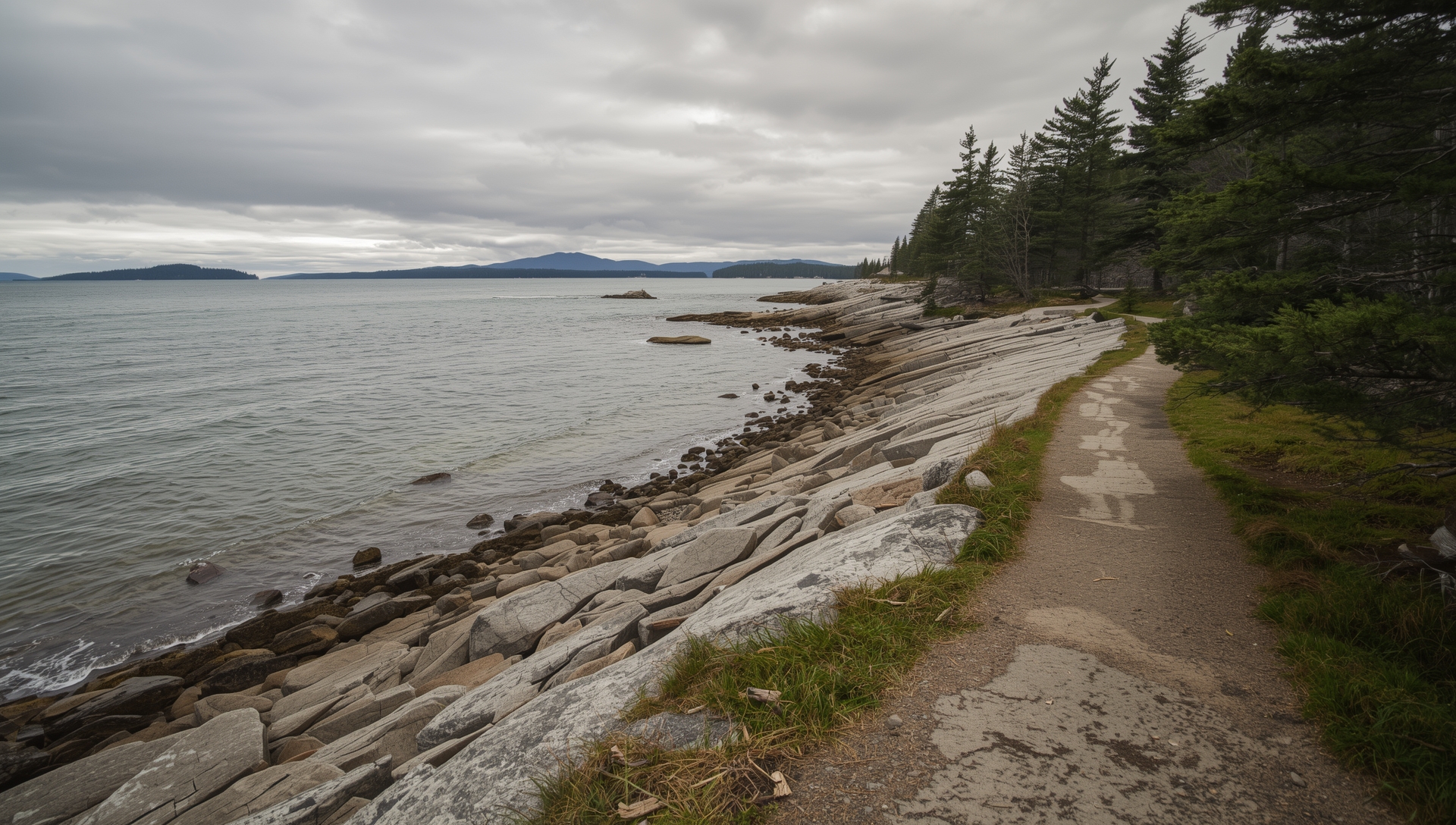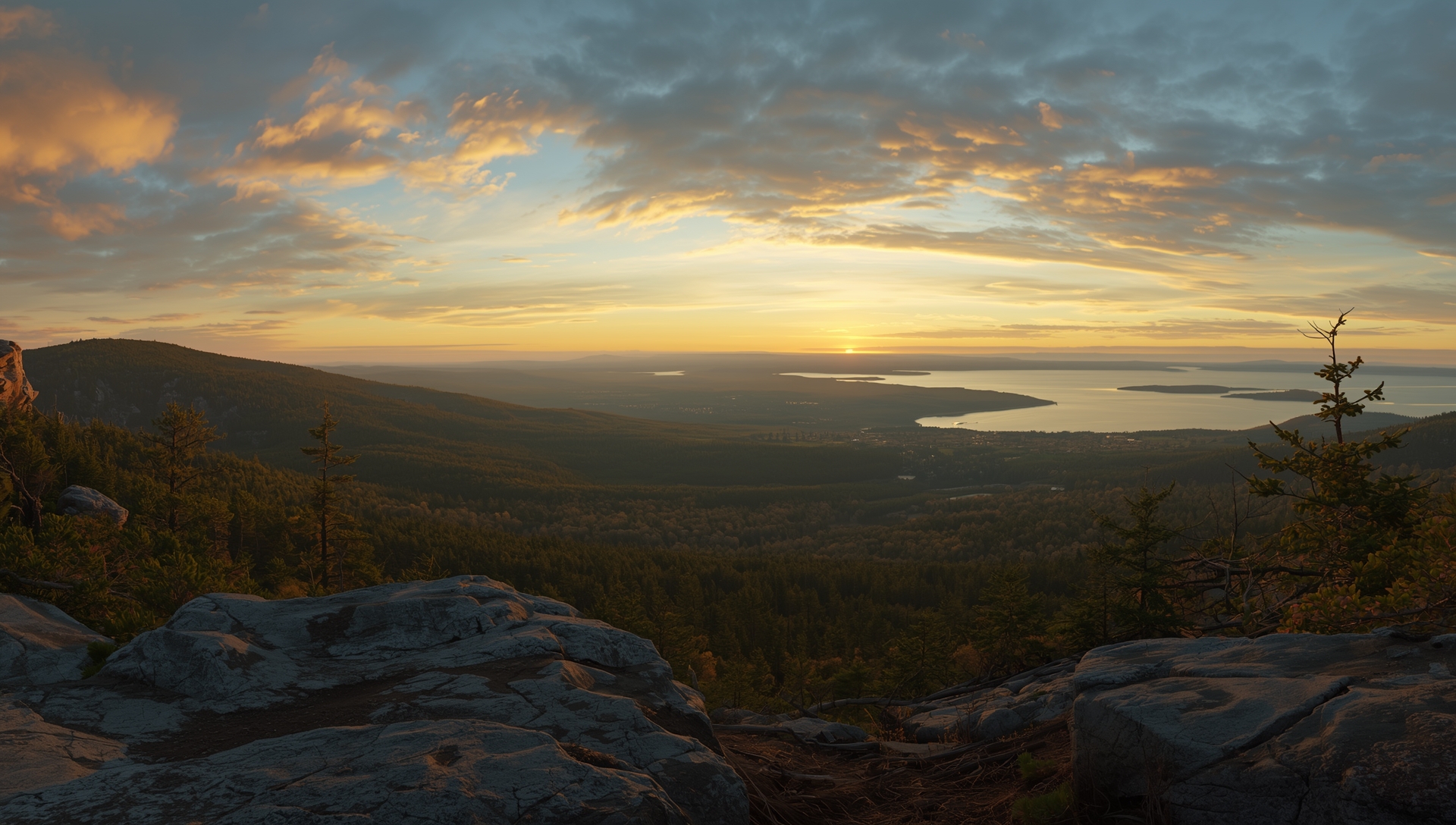Trails in Acadia National Park
Exploring the Trails in Acadia National Park
Trails in Acadia National Park reveal the heart and soul of Mount Desert Island — where rugged granite cliffs meet peaceful forests and ocean views that seem endless. With more than 120 miles of routes winding across mountains, lakes, and shorelines, Acadia offers something for everyone, from adventurous climbers to families seeking a scenic stroll. Each path here feels like its own story — a moment of connection between land and sea, challenge and calm.
Some of the most iconic routes are the Beehive Trail Acadia and Precipice Trail Acadia National Park, both known for their thrilling iron rungs and breathtaking cliffside views. Hikers who prefer a gentler experience often find joy in the Ocean Path Trail, Jordan Pond Trail Acadia, and Wonderland Trail, where the air smells of salt and pine, and seabirds glide overhead. If you crave elevation, the Cadillac Mountain Trail, Dorr Mountain South Ridge, and Penobscot Mountain Trail climb to granite summits with views stretching over Frenchman Bay and the Cranberry Isles.
But not all beauty in Acadia is grand. Many trails reveal quiet moments — mossy paths through spruce-fir forests, reflections on still ponds, and the soft hush of wind across open ledges. Trails like Jesup Path, Great Meadow Loop, and Flying Mountain Trail remind visitors that peace and perspective often come from the gentlest walks.
Whether you’re here for an afternoon outing or a full-day adventure, Trails in Acadia National Park offer an experience that’s both grounding and unforgettable. These paths invite you to slow down, breathe in the coastal air, and rediscover the rhythm of nature — one step at a time.
- Main Routes: Beehive Trail, Precipice Trail, Ocean Path Trail, Jordan Pond Path.
- Mountain Hikes: Cadillac Mountain Trail, Dorr Mountain Trail, Penobscot Mountain Trail.
- Family Favorites: Wonderland Trail, Jesup Path, Great Meadow Loop, Flying Mountain Trail.
- Trail Lengths: From half-mile loops to full-day summit climbs.
- Best Seasons: Late spring through autumn for clear skies and colorful views.
Cliff and Ladder Trails in Acadia National Park
Few hiking destinations in America inspire quite the same mix of excitement and awe as the cliff and ladder trails in Acadia. These routes are where hiking meets light climbing — narrow ledges, vertical rungs, and breathtaking exposure that make every step feel like a small victory. The experience isn’t about distance or elevation alone, but about perspective: how you see the land, the sea, and your own sense of courage from new heights. Among these routes, the Beehive Trail Acadia and the Precipice Trail Acadia stand at the top of nearly every visitor’s list, offering signature adventures that showcase the wild, vertical heart of Mount Desert Island.
The Beehive Trail Acadia is often the first cliff trail hikers tackle, partly because it’s short and easy to access, but mostly because it’s thrilling from the very first step. The trail begins across from Sand Beach on the Park Loop Road, climbing abruptly up a steep granite face. Iron rungs, handholds, and narrow ledges trace the path skyward, wrapping around the exposed dome of The Beehive. For much of the climb, the ocean shimmers below, with Sand Beach forming a perfect crescent of gold against the blue Atlantic. Every rung gives a sense of accomplishment, and every turn opens up a new, dizzying view of Acadia’s coastal cliffs and forests.
At the summit, hikers are greeted with one of the park’s most iconic panoramas — a sweeping view that includes Frenchman Bay, the Porcupine Islands, and the ridges of Gorham Mountain. Many loop back down via The Bowl Trail, a gentler route that descends through pine forest to a quiet pond, offering a calm, reflective contrast to the adrenaline of the ascent. It’s a perfect introduction to what makes hiking Acadia National Park so special: variety, challenge, and an unshakable sense of reward.
A few miles to the south, the Precipice Trail Acadia delivers the park’s ultimate cliff-climbing experience. Rising nearly 1,000 feet in less than a mile, this is not just a trail — it’s an adventure carved into the face of Champlain Mountain. Iron rungs and ladders assist hikers up vertical sections, while narrow ledges trace dizzying drop-offs with views stretching across Frenchman Bay to Bar Harbor. The sense of exposure is intense, but the footing is secure, and the route is designed with built-in safety features that make the challenge accessible to experienced hikers who respect the risks. The ascent demands focus, but the payoff is extraordinary: a broad, wind-swept summit overlooking the ocean, the Schoodic Peninsula, and the rugged sprawl of Mount Desert Island.
Because both the Beehive Trail Acadia and Precipice Trail Acadia are key peregrine falcon nesting sites, they close each spring and early summer to protect the birds. These seasonal closures are part of what makes hiking Acadia National Park unique — a place where conservation and recreation are balanced beautifully. Rangers reopen the trails once the young falcons have fledged, usually by mid-summer, and updates are posted at visitor centers and online. Planning ahead ensures you don’t miss your chance to experience these legendary climbs.
For those new to ladder routes, starting with Beehive is wise before attempting Precipice. The shorter distance and slightly lower exposure make it ideal for building confidence. Carrying only essential gear, keeping three points of contact on ladders, and avoiding these trails in wet or foggy weather are key to a safe ascent. Even seasoned hikers find that patience and awareness are more valuable than speed.
You can explore each of these trails in detail through the dedicated pages — Beehive Trail Acadia National Park and Precipice Trail Acadia National Park — where you’ll find maps, tips, and photos of each climb. Together, they define the spirit of adventure that makes trails in Acadia National Park unforgettable: a blend of courage, craftsmanship, and the sheer beauty of granite rising above the sea.
- Beehive Trail Acadia: Famous for its iron rungs, exposed granite, and stunning views over Sand Beach and Frenchman Bay.
- Precipice Trail Acadia: The park’s most thrilling climb up Champlain Mountain with vertical ladders and narrow ledges.
- Cliff and Ladder Routes: Signature experiences that combine hiking and light climbing — short but steep, scenic, and unforgettable.
- Best Time to Visit: Trails reopen mid-summer after peregrine falcon nesting season; avoid wet or foggy days for safety.
- Alternate Descent: The Bowl Trail offers an easier return from Beehive, circling through peaceful forest and ponds.
- Essential Tips: Keep three points of contact on ladders, pack light, and check current trail conditions at visitor centers.
- Don’t Miss: Sunrise from Beehive summit and panoramic ocean views from the top of Champlain Mountain.
- Learn More: Explore detailed guides for Beehive Trail Acadia National Park and Precipice Trail Acadia National Park to plan your climb.
Summit and Ridge Trails in Acadia National Park
The Summit and Ridge Trails in Acadia National Park reveal a completely different side of the park — one that’s less about adrenaline and more about awe. These are the trails that lift you above the tree line, opening up the full sweep of Mount Desert Island and the Atlantic beyond. Whether you’re standing on the pink granite crown of Cadillac Mountain or tracing the quiet ridges near Beech and Bernard, the feeling is the same: space, light, and an unmistakable connection to the landscape that defines Acadia.
Among the most iconic summit routes is the Cadillac Mountain North Ridge Trail, a steady, rewarding climb that follows granite slabs and weathered cairns all the way to the highest point on the U.S. Atlantic coast. It’s one of those hikes where the view keeps widening as you go — forest giving way to ocean, small islands dotting Frenchman Bay, and the distant horizon blurring into sky. Sunrise here is famous, but even a mid-day hike feels special, especially when sea breezes roll across the summit. For a quieter alternative, the Cadillac Mountain South Ridge Trail offers the same expansive scenery with fewer crowds and a slightly wilder feel.
To the east, Dorr Mountain delivers a classic Acadia climb that’s both steep and intimate. The Dorr Mountain South Ridge Trail winds through groves of spruce and birch before emerging onto open granite ledges with sweeping views toward Bar Harbor and the Porcupine Islands. Hikers looking for an extra challenge can link the Ladder Trail to the Dorr Summit, creating one of the most dynamic loop hikes in the park — a combination of forest shade, rocky scrambles, and ridge-top breezes that capture everything people love about Acadia.
Further west, the landscape softens into long undulating ridges. Beech Mountain, with its historic fire tower, offers a family-friendly hike that still rewards with spectacular views over Echo Lake and the Cranberry Isles. The Beech Mountain South Ridge Trail and the Beech Cliff Loop showcase how Acadia’s western slopes blend forest, granite, and water in a way that feels both rugged and peaceful. Nearby Bernard Mountain and Western Mountain are often overlooked but provide solitude and perspective — ideal for those who want the beauty without the bustle.
The Penobscot Mountain and Sargent Mountain ridges, above Jordan Pond, are pure Acadia magic. The open granite tops here are perfect for longer traverses, with 360-degree views that take in both ocean and interior peaks. Many hikers combine the two summits in a single day, linking the Penobscot Mountain Trail and the Sargent South Ridge Trail into one of the park’s most scenic ridge walks. From the summit, you can trace the curving shape of Somes Sound, see the sparkling water of Jordan Pond below, and feel that quiet satisfaction of being exactly where you’re meant to be.
Each of these Summit and Ridge Trails in Acadia National Park shares a common thread: that blend of challenge and beauty that makes Acadia unforgettable. None are extreme in elevation, but every one feels elevated — in spirit, in view, and in experience. They’re the places where you’ll pause without meaning to, just to listen to the wind moving through the pines or to watch sunlight drift over the bay.
If you’ve already explored the cliffs and ladders and want to slow things down, the ridges are where you’ll find your rhythm again. These summits don’t demand speed; they reward stillness. Whether you’re watching clouds slide across Cadillac or tracing the long ridgeline toward Sargent, every step feels like a conversation with the land — quiet, grounding, and deeply Maine.
- Cadillac Mountain North Ridge Trail: Acadia’s highest summit with sunrise views across Frenchman Bay.
- Dorr Mountain South Ridge Trail: A classic climb mixing forest shade, open granite, and sweeping island views.
- Beech Mountain South Ridge Trail: Gentle gradients, forest serenity, and a historic fire tower at the top.
- Penobscot & Sargent Ridge: Linked trails that reveal Acadia’s grandest 360° panoramas over Jordan Pond.
- Bernard & Western Mountains: Quieter ridges offering solitude, pine-scented air, and Maine’s coastal calm.
Coastal and Forest Trails in Acadia National Park
While the summits show you Acadia from above, the Coastal and Forest Trails in Acadia National Park bring you back down to earth — to the rhythm of the waves, the scent of spruce, and the hush of moss-covered woods. These are the trails that reveal the quieter side of Mount Desert Island, where granite meets tide, and sunlight filters through evergreens instead of blazing across open ledges. Every step along the coast or through the forest feels like a conversation between sea and stone.
The most beloved of the coastal routes is the Ocean Path Trail, an easy, scenic walk that follows the shoreline between Sand Beach and Otter Point. It’s the perfect introduction to the park’s dramatic seaside cliffs — the thunder of waves, the smell of salt in the air, and the views that make you stop without realizing it. The Thunder Hole lookout sits midway along the route, where incoming surf roars into a natural cavern and echoes like distant thunder. For photographers, this stretch of trail is irresistible at sunrise, when the granite glows pink and the Atlantic shimmers with reflected light.
Just beyond, the Great Head Trail loops around a forested peninsula above Sand Beach. Short but steep in sections, it rewards hikers with sweeping views of the beach below and the Beehive rising in the distance. The combination of crashing surf and rugged cliffside walking makes it one of Acadia’s signature experiences — especially in the early morning when fog lifts off the ocean. A little farther south, the Ship Harbor Trail and Wonderland Trail near Bass Harbor provide gentler alternatives. Both follow flat, coastal terrain where spruce roots twist through the soil and tidal pools glint with reflected sky. These trails are ideal for families or anyone seeking a slower pace; the reward is the meditative sound of the waves and the discovery of tiny marine worlds at low tide.
Venturing inland, the forest paths reveal Acadia’s other face — cool, green, and deeply peaceful. The Jesup Path is a wooden boardwalk weaving through a white-birch forest near the Sieur de Monts area. In autumn, the canopy turns gold, and the whole path seems to glow. Paired with the Great Meadow Loop, it creates a leisurely walk full of bird song and reflections in still pools. Farther north, the Hemmingway–Bingham Path near Eagle Lake and the Hadlock Brook Trail wind through spruce-fir woods with mossy boulders and soft ground underfoot, offering that quiet intimacy only forest trails can give.
The Lower Harbor Trail on the Schoodic Peninsula combines both worlds: ocean views on one side, dense woodland on the other. This less-visited corner of Acadia is a reminder that the park extends beyond Mount Desert Island, with scenery just as spectacular and trails that feel wonderfully remote. On calm days, you can hear gulls and the gentle splash of the tide; on stormy ones, the Atlantic pounds the rocks in a show of power that humbles everyone who witnesses it.
Each of these Coastal and Forest Trails in Acadia National Park brings its own rhythm. Some invite long, thoughtful walks; others deliver instant beauty within minutes of leaving the trailhead. Together, they form the connective tissue of Acadia — paths that lead you to the park’s heart rather than its heights. While the summits fill you with awe, these trails ground you in stillness. They’re where you notice the small things: the pattern of lichens on rock, the echo of a woodpecker, the smell of salt carried inland by the breeze.
Hiking these coastal and woodland paths feels like rediscovering simplicity. No ladders, no steep scrambles — just the honest joy of being outside in a place where sea, forest, and granite share the same horizon. Whether you start from Sand Beach, Bass Harbor, or the quiet boardwalks near Sieur de Monts, you’ll find that the beauty of Acadia doesn’t always require altitude. Sometimes, the best views are at eye level — where the ocean sparkles between trees and the world slows down to the pace of your footsteps.
- Ocean Path Trail: Easy seaside walk from Sand Beach to Otter Point with waves, cliffs, and sunrise views.
- Great Head Trail: Short coastal loop above Sand Beach with sweeping views of the Beehive and Atlantic horizon.
- Ship Harbor & Wonderland Trails: Gentle coastal routes near Bass Harbor — family friendly with tidepools and sea air.
- Jesup Path & Great Meadow Loop: Peaceful forest boardwalks near Sieur de Monts surrounded by birch and songbirds.
- Lower Harbor Trail (Schoodic Peninsula): Quiet path balancing ocean views and forest stillness far from the crowds.
Carriage Roads and Connector Trails in Acadia National Park
Few places capture the harmony between human design and natural beauty like the Carriage Roads and Connector Trails in Acadia National Park. These pathways — a gift from philanthropist John D. Rockefeller Jr. — are both elegant and enduring, built from native granite and curved to fit the land rather than reshape it. They form the park’s most peaceful network: wide, car-free lanes ideal for walking, cycling, and horseback riding. While other trails climb, twist, and test your balance, the carriage roads invite you to slow down and simply move through the landscape.
The network stretches for about 45 miles, connecting some of Acadia’s most beloved features. Each road feels thoughtfully placed — following contour lines, crossing brooks with hand-crafted stone bridges, and winding through spruce forests, open meadows, and lakeshores. It’s this combination of engineering and artistry that makes them so special. Every curve and viewpoint feels intentional, designed to showcase nature’s best angles.
One of the most iconic routes begins near Eagle Lake, circling its shore in a gentle loop framed by mountains on all sides. Early morning mist floats above the water as cyclists and walkers glide along the smooth gravel. Nearby, the Jordan Pond Road branches off toward the famous pond and its twin peaks, the Bubbles, offering some of the most photogenic scenery in the park. Whether you’re pedaling past still reflections or pausing for tea at the Jordan Pond House, it’s easy to see why this stretch is so loved.
Further afield, the Day Mountain Carriage Road climbs steadily to the summit, rewarding those on foot or bike with panoramic views over Seal Harbor and the Cranberry Isles. Unlike the rugged hiking trails, this ascent is gradual and forgiving, making it one of the best routes for visitors seeking summit views without the scrambles. On clear days, the ocean glimmers through the trees — a reminder that in Acadia, sea and mountain are never far apart.
Beyond Mount Desert Island, a separate network of Carriage Roads in Schoodic Peninsula offers the same grace and craftsmanship with even fewer visitors. Here, forest solitude meets coastal air, and the roads loop quietly through spruce groves and over smooth granite ridges. The Schoodic roads are newer but built in the same spirit — a continuation of Rockefeller’s vision for timeless, car-free travel through the wilderness.
The Connector Trails in Acadia National Park tie everything together. These smaller paths link carriage roads to hiking routes, lakes, and viewpoints, creating endless combinations for exploration. Trails like the Around Mountain Carriage Connector and Triad Path allow you to blend gentle cycling with more challenging hikes. You can begin your day pedaling from Jordan Pond, leave your bike at a trail junction, and continue on foot to summits like Penobscot or Sargent. For those who love variety, it’s the ultimate Acadia experience — freedom to move from road to trail to ridge at your own pace.
What makes these roads and connectors so appealing is their rhythm. They’re wide enough for conversation, quiet enough for solitude, and scenic enough that even a short ride feels significant. In spring and summer, wildflowers edge the roadsides. Autumn brings a blaze of color — amber, crimson, and gold arching over every bend. Winter transforms them again: cross-country skiers trace the same routes, gliding over snow that softens every sound.
For families, the Carriage Roads and Connector Trails in Acadia National Park are the safest and most accessible way to see the park. There’s no need for technical gear or mountain stamina — just a sense of curiosity. Benches and rest spots appear at regular intervals, perfect for picnics and photos. For photographers and naturalists, they offer endless compositions: light on stone bridges, reflections in ponds, the silhouette of a horse-drawn carriage against the trees.
Whether you’re cycling beneath beech leaves, walking beside Eagle Lake, or following a quiet connector to a mountain trail, these roads embody the spirit of Acadia — deliberate, enduring, and beautiful from every angle. They remind you that not every path has to conquer a peak; some simply help you find your way back to peace.
- Eagle Lake Loop: Classic carriage route circling calm waters with reflections of surrounding peaks.
- Jordan Pond Road: Scenic ride or walk leading to the iconic pond and twin Bubbles with sweeping views.
- Day Mountain Carriage Road: Gradual climb to ocean vistas — ideal for cycling and family exploration.
- Schoodic Carriage Roads: Peaceful, less-traveled routes through spruce forests and granite ridges on the peninsula.
- Connector Trails: Short linking paths joining carriage roads to hiking trails, summits, and lakes — perfect for mixed adventures.
Lakeside and Valley Trails in Acadia National Park
The Lakeside and Valley Trails in Acadia National Park reveal the gentler heart of this rugged coastal landscape. Here, the drama of cliffs gives way to still water, soft light, and quiet forest reflections. These trails trace the edges of glacial ponds and weave through green valleys carved long ago by ice, offering the kind of calm that makes you slow your step and listen — to wind in the pines, loons calling across the water, and the rhythmic crunch of gravel beneath your boots.
Among the most beloved routes is the Jordan Pond Path, a near-perfect circle around one of Acadia’s most photographed spots. The pond’s clear, glassy surface mirrors the twin peaks of the Bubbles, while the trail itself alternates between shaded forest and open shoreline. Boardwalks cross sensitive wetlands, and every turn seems to frame another postcard view. Early morning or evening brings the best light — golden reflections that make this one of the park’s most peaceful walks.
A short drive away lies Bubble Pond, a quieter alternative for those seeking solitude. The Bubble Pond Trail follows the water’s edge beneath spruce and birch trees, its stillness often disturbed only by the faint rustle of leaves or the dip of a paddle from kayakers gliding silently offshore. This is a place where time stretches — where a half-hour walk can easily become two.
Further west, the Witch Hole Pond Loop offers another lakeside gem that’s perfect for walkers, cyclists, and birdwatchers alike. The loop connects with the carriage road network, creating an easy circuit with gentle grades and abundant wildlife. Ducks, herons, and sometimes even beavers can be spotted near the marshy edges. The mirrored reflections of autumn color here are breathtaking, with the water turning into a painter’s palette of amber, crimson, and gold.
For visitors wanting to experience Acadia’s valleys, the Hadlock Ponds Trails are a natural next stop. The Upper Hadlock Pond Trail winds past a stone carriage bridge, its arches mirrored in the water below — one of the most photographed landmarks in the park. The Lower Hadlock Trail, quieter and more shaded, runs through deep forest with the soft scent of moss and pine. Together, these routes showcase how diverse Acadia’s freshwater landscapes can be: one moment open and sunlit, the next hushed and green.
The Duck Brook Path connects Eagle Lake to Bar Harbor via a series of valley crossings, blending lakeside walking with light elevation changes. It’s a favorite for those who want variety without steep climbs. In spring, the brook runs high with meltwater; in autumn, fallen leaves drift along its current like confetti. For families and photographers, this balance of movement and stillness makes it one of Acadia’s hidden treasures.
Not all valley trails are soft and shaded — some open dramatically onto views. The Hadlock Brook Trail, for instance, offers glimpses of granite ridges and distant summits between its forested sections. Hikers who take their time may spot deer drinking from the streams or tiny red squirrels darting between tree roots. For those who prefer solitude over spectacle, this is the Acadia that feels most personal — not the park of crowds and cameras, but of whispers and details.
In many ways, the Lakeside and Valley Trails in Acadia National Park are the park’s connective tissue. They link highland routes to the carriage roads and allow visitors to explore a softer dimension of the landscape. Whether you’re tracing the smooth shoreline of Jordan Pond, following the shaded bends of Witch Hole Loop, or listening to the echo of loons at Bubble Pond, these trails remind you that adventure doesn’t always mean altitude. Sometimes, it’s found in still water, cool shade, and the rhythm of an easy step beside a quiet pond.
- Jordan Pond Path: Flat, scenic loop with mirrored views of the Bubbles and shaded forest boardwalks.
- Bubble Pond Trail: Quiet lakeside walk beneath birch trees — perfect for solitude and reflection.
- Witch Hole Pond Loop: Easy circuit shared by walkers and cyclists, known for autumn reflections and birdlife.
- Hadlock Ponds Trails: Upper and Lower Hadlock routes feature forest serenity and iconic stone bridges.
- Duck Brook Path: Gentle valley route linking Eagle Lake to Bar Harbor with streams and subtle elevation changes.
Trail Maps and Navigation in Acadia National Park
Getting around Acadia’s vast trail system can feel like unfolding a secret, one ridge and cove at a time. While the park’s beauty is immediate, understanding its layout transforms an enjoyable walk into a truly memorable day. From paper maps to GPS apps, visitors have more tools than ever to navigate Acadia National Park’s trails confidently — but the best adventures still begin with a bit of planning.
The official Acadia National Park trail map is the single most useful resource for visitors. It shows more than 120 miles of routes crisscrossing Mount Desert Island, Schoodic Peninsula, and Isle au Haut. Each section highlights elevation, difficulty, and connecting points, making it easy to link short strolls like the Jesup Path with longer hikes such as Dorr Mountain Trail or Pemetic Mountain Loop. Many visitors find that carrying a printed version is reassuring, especially in areas where cell service fades — which is frequent once you move into the island’s interior valleys.
Digital navigation has its place too. Apps such as Gaia GPS, AllTrails, or the official NPS app can track your progress and provide offline downloads for trails like Beehive Trail, Acadia Mountain Trail, and the Ocean Path Trail. However, seasoned hikers often recommend combining both paper and digital — the map for planning, the GPS for orientation, and your senses for everything in between. Trail markers, known locally as cairns, guide the way across open granite. They’re easy to follow when the light is good, but can blend into the landscape under fog, snow, or dusk. Respecting these stone markers — and not building your own — is one of Acadia’s oldest hiking courtesies.
For those exploring the Carriage Roads, navigation is even smoother. These historic pathways, built by John D. Rockefeller Jr., are wide, graded, and numbered with distinctive signposts at every junction. Cyclists, walkers, and horseback riders can easily orient themselves using the Carriage Road Map available at visitor centers or online. The roads also connect to several hiking trailheads, creating opportunities for loop routes that mix both terrain types — for example, a cycle from Eagle Lake followed by a climb up Conners Nubble Trail.
If you’re visiting in summer, rangers at the Hull’s Cove Visitor Center can help match maps to your skill level or the time you have available. In quieter months, the Acadia National Park trail map PDF remains the go-to planning tool, easily downloadable before your trip. Whether you’re tracing coastline routes like the Great Head Trail, scaling granite ridges such as Beehive, or exploring shaded walks like Wonderland Trail, knowing the terrain helps you balance ambition with enjoyment.
One often overlooked part of trail planning is timing. Many of Acadia’s paths are one-way ascents that descend by alternate routes — a detail that catches out newcomers on steep climbs like Precipice Trail or Cadillac North Ridge Trail. Checking contour lines on a map can save you from exhausting climbs when you expected an easy walk. Equally, planning for changing conditions is vital: a fog-covered morning can quickly turn sunny, while a warm afternoon near Jordan Pond might be breezy on Cadillac’s summit.
Ultimately, maps do more than direct you — they reveal connections. They show how a quiet forest track can lead to an ocean overlook, how trails interlace across the park like living veins. Understanding those lines deepens your experience and encourages responsible exploration. Whether you unfold a printed map or swipe across your phone, each path in Acadia leads to discovery — and to the realization that getting lost, even just a little, is sometimes part of the magic.
- Trails in Acadia National Park: More than 120 miles of hiking routes connect Mount Desert Island, Schoodic Peninsula, and Isle au Haut.
- Acadia National Park Trail Map: Essential for planning routes like Beehive Trail Acadia, Precipice Trail Acadia, and Cadillac North Ridge Trail.
- Navigation Tools: Combine paper maps with GPS apps for Acadia Hiking Trails to stay oriented even where service drops.
- Carriage Trails Acadia National Park: Numbered junctions and signposts make for easy exploration by bike or on foot.
- Safety Tip: Follow cairns carefully on open granite sections, especially along coastal routes like Ocean Path Trail Acadia and Great Head Trail Acadia.
You Can’t Do One Without the Other
Sister Trails in Acadia National Park
Some trails in Acadia National Park feel like they were designed to go together. They twist, merge, and part again, creating natural pairs that make a single hike feel like a complete story. You can hike one, of course—but the real magic happens when you link its sister trail and see how the landscape changes from every angle. These connected routes show why Acadia’s trail system is so beloved: compact, scenic, and endlessly rewarding for those willing to explore beyond the obvious turn-around points.
The most famous duo is the Beehive Trail Acadia and Bowl Trail. Hikers often tackle the Beehive’s iron rungs first—gripping metal ladders that scale open cliffs above Sand Beach and Frenchman Bay. It’s short, steep, and unforgettable. But the descent via the Bowl Trail transforms the outing from a quick thrill to a full-circle experience. The forest path winds gently toward a quiet pond framed by spruce and fir, offering cool shade and calm water after the exposed climb. The two trails balance each other perfectly—one heart-pounding, one heart-soothing.
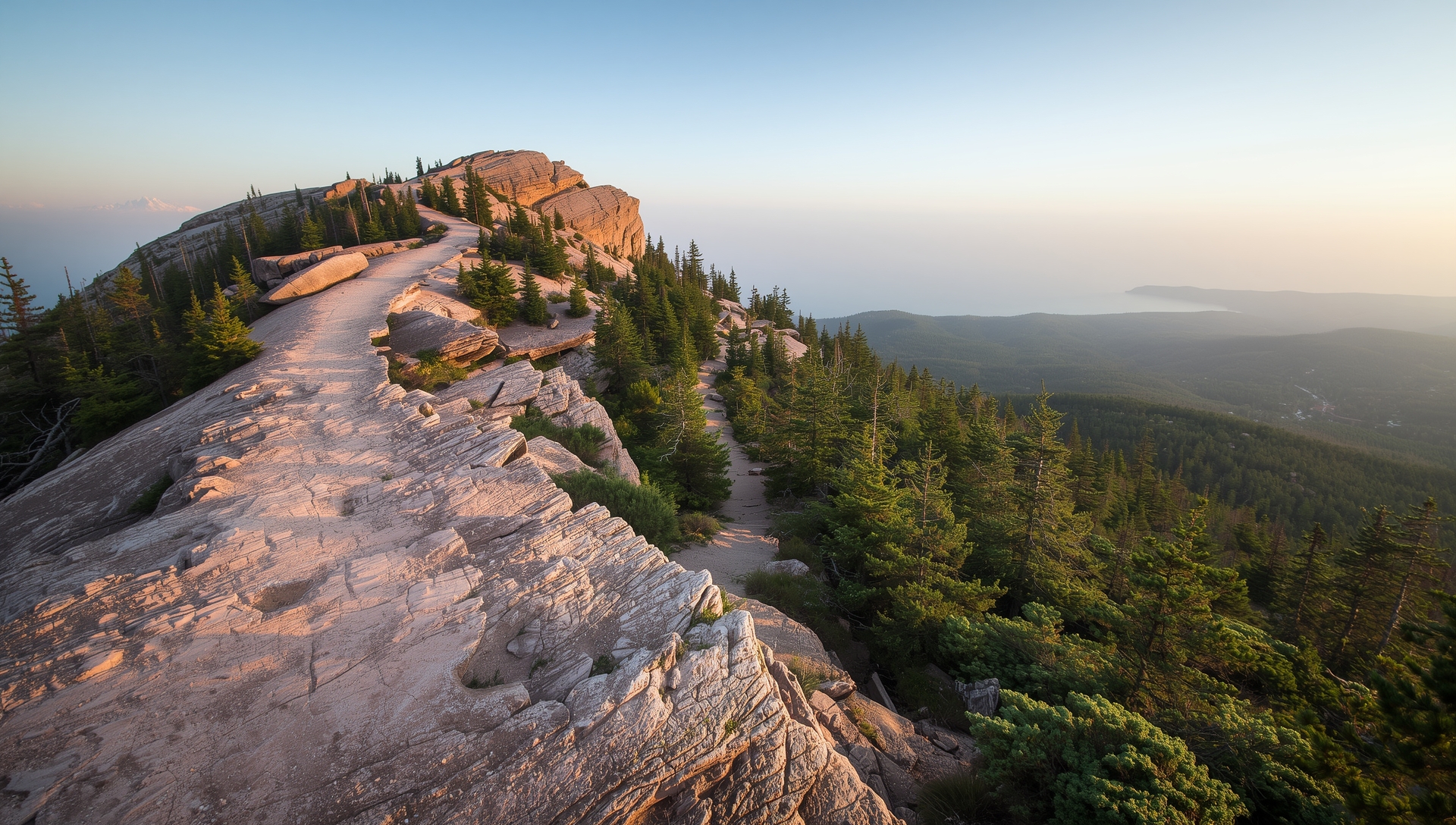
Next comes the legendary Precipice Trail Acadia. This climb up Champlain Mountain is Acadia’s boldest, following a vertical maze of rungs and ledges with dizzying Atlantic views. But the real secret is not turning back the same way. Linking it with the Champlain North Ridge Trail creates a loop that trades the sheer ascent for an easy, panoramic descent. You can see Mount Desert Island unfold beneath you, and the sea glittering far below. One trail tests your nerve; the other rewards your effort. Together, they define what hiking Acadia National Park is all about.
Over near Jordan Pond, the South Bubble Trail and Bubble Rock Trail make another ideal pair. The South Bubble climb is short and sharp, leading to the park’s famous perched boulder—a massive glacial rock balanced improbably above the valley. Yet few visitors know how close they are to Bubble Rock’s gentler return route. The loop back passes through birch forest and down toward the shimmering waters of Jordan Pond, completing a hike that captures both Acadia’s drama and serenity in less than two miles.
On the quieter western side, Beech Mountain Trail and Beech Cliff Trail combine summit views and lakeside ladders. The Beech Mountain loop leads to the historic fire tower and wide-open ledges overlooking Echo Lake. Add the Beech Cliff Trail, and you’ll descend via dramatic switchbacks and iron-rung viewpoints that hover above the lake’s blue surface. It’s the kind of pairing that keeps photographers lingering long after the hike is done.
Even Cadillac Mountain has its own set of complementary routes. The Cadillac North Ridge Trail offers the classic sunrise climb—steady, open, and scenic all the way up. The South Ridge Trail, longer and quieter, makes an ideal return, winding past granite domes, spruce stands, and glimpses of the Cranberry Isles. Together, they form the ultimate summit loop, a full-day adventure for those seeking both challenge and solitude.
Acadia’s trail map is dotted with these natural partnerships. Some loops, like Ocean Path Trail Acadia paired with Gorham Mountain Trail, offer contrasts between sea spray and mountaintop breezes. Others, such as Penobscot Mountain Trail and Jordan Pond Path, mix elevation with reflection, showing how one landscape flows into another. The key is to approach each hike with curiosity—study the map, look for intersecting trails, and see where one ridge or valley might lead.
In the end, hiking in Acadia National Park isn’t just about reaching summits. It’s about discovering how the park’s trails connect—how every ridge has a twin, every climb has a calm, and every path tells half a story until you link it with the next. These sister trails remind you that in Acadia, you really can’t do one without the other.
- Beehive Trail Acadia + Bowl Trail: Combine thrill and tranquility in one unforgettable loop.
- Precipice Trail Acadia + Champlain North Ridge Trail: Ascend by ladders, descend by panoramic ridge.
- South Bubble Trail + Bubble Rock Trail: Iconic boulder views and serene forest descent.
- Beech Mountain Trail + Beech Cliff Trail: Fire tower vistas meet Echo Lake overlooks.
- Cadillac North Ridge Trail + South Ridge Trail: Experience sunrise to summit in Acadia National Park.
Seasons and Trail Experiences in Acadia National Park
Acadia’s trails tell a different story each season. The same paths that glow with spring wildflowers feel completely transformed beneath autumn leaves or winter frost. That’s part of what makes hiking Acadia National Park so rewarding — every visit brings something new. Whether you come for sunshine, solitude, or sea fog, the rhythm of the year shapes every step you take.
Acadia in Spring
Acadia in spring feels alive after the stillness of winter. Meltwater streams down granite ridges, and trails like Beech Mountain Trail and Jordan Pond Path sparkle with the sound of running water. Early May brings the first wildflowers — trillium, violets, and lupine — painting the forest floor along lower elevation routes such as Wonderland Trail Acadia and Jesup Path. Cooler temperatures and fewer visitors make this one of the best times to enjoy trails in Acadia National Park without the summer rush. Just remember: snowmelt can leave sections muddy, so waterproof shoes or hiking boots are essential.
For photographers and birdwatchers, Acadia in Spring offers a softer palette and peaceful mornings, when loons call from Echo Lake and fog drifts through spruce forest. It’s the season of renewal, and every trail feels like it’s waking up with you.
Acadia National Park in Summer
Acadia National Park in Summer is when Acadia National Park hiking trails are at their liveliest. Long daylight hours and steady sunshine invite exploration from dawn to dusk. The Beehive Trail Acadia buzzes with climbers tackling its famous iron rungs, while Ocean Path Trail Acadia fills with families following the coast toward Thunder Hole. Higher routes like Cadillac North Ridge Trail and Dorr Mountain Trail reward early risers with dazzling sunrises and ocean views that stretch for miles.
This is also the best season for pairing hikes with swims — Beech Cliff Trail ends just above Echo Lake, where the cool water feels like heaven after a warm climb. The park is busiest now, so starting early or choosing quieter routes on the western side ensures you’ll still find solitude. Trails like Flying Mountain Trail and Ship Harbor Trail Acadia reveal the gentler, more personal side of hiking Acadia National Park during its busiest months.
Acadia in the Fall
Acadia in the fall transforms Acadia into a painter’s dream. Fiery reds, burnt oranges, and glowing golds blanket the mountains and valleys. Acadia in Fall is a season that turns even simple routes — like Jordan Pond Path or South Bubble Trail — into postcard scenes. Crisp mornings and low sunlight create perfect hiking weather.
The Beech Mountain Trail and Penobscot Mountain Trail are particularly striking, as their open ledges provide wide-angle views of forests ablaze with color. Cooler temperatures and lighter crowds make this one of the most popular times for photographers and long-distance hikers. Every viewpoint feels sharper, every color more vivid. Fall in Acadia doesn’t just decorate the trails; it defines them.
Acadia National Park Winter
An Acadia National Park winter is a time of profound peace and tranquility. Many trails close or become snow-covered, but some — like Carriage Trails Acadia National Park and sections of Ocean Path Trail Acadia — remain accessible for snowshoeing and cross-country skiing. Acadia in Winter is the park’s quietest season, when the sound of crunching snow replaces the chatter of summer hikers.
Hiking here now means solitude: icy cliffs, frosted evergreens, and clear horizons where Mount Desert Island meets the sea. On sunny days, Cadillac South Ridge Trail offers breathtaking winter views that feel almost otherworldly. The stillness invites reflection — it’s not about covering miles, but about standing still and realizing how alive the landscape remains beneath the snow.
- Acadia in Spring: Waterfalls, wildflowers, and quiet forest paths before summer crowds.
- Acadia in Summer: Long days, vibrant climbs, and cool lake swims after coastal trails.
- Acadia in Fall: Golden forests and crisp mountain air on every ridge and loop.
- Acadia in Winter: Snow-covered tranquility and reflective hikes on peaceful carriage trails.
Hidden Gems: Lesser-Known Trails in Acadia National Park
Not every path in Acadia National Park makes the postcards. Some are tucked away behind quiet lakes, hidden in spruce forests, or threading through the park’s less-visited corners. These lesser-known trails in Acadia National Park reveal a softer side of the landscape — the moments when you hear birds instead of crowds and discover how solitude brings the park’s wild beauty into sharper focus.
One of the best examples is the Alder Trail, a gentle walk near Schoodic Peninsula where boardwalks wind through wetlands alive with frogs and reeds. It’s a completely different rhythm from Acadia’s summits. Early morning mist hovers over still pools, and in autumn, the alder leaves glow a luminous gold. Just nearby, the Lower Harbor Trail skirts the coastline, tracing granite shelves where waves whisper rather than crash — a perfect choice for those seeking calm.
Closer to Mount Desert Island’s quieter west side, the Flying Mountain Trail offers a brief but breathtaking climb. Though less than a mile long, it rewards hikers with sweeping views across Somes Sound, the only fjard in the United States. The trail’s short distance and high reward make it a favorite for locals who know how to avoid the midday crowds. Nearby, the Valley Cove Trail descends through forests to a secluded shoreline where the sound of water lapping against stone feels almost meditative.
In the Beech Mountain area, the Beech Cliff Loop remains one of the most overlooked adventures. Iron ladders climb a series of cliffs that lead to dramatic views of Echo Lake, yet the trail sees only a fraction of the visitors who flock to the Beehive or Precipice. It’s a perfect compromise — thrilling but manageable, wild but accessible. On the descent, moss-lined ledges and quiet forest paths return hikers to the lake’s edge, creating a loop that feels perfectly complete.
Those who explore beyond Mount Desert Island often find the Anvil Trail on Schoodic Peninsula particularly rewarding. Rising steadily through spruce forest to a granite overlook, it offers vast views of Frenchman Bay and Mount Desert Island beyond. It’s not as famous as the Park Loop Road hikes, but the solitude and views are every bit as spectacular. Nearby, the Alder Trail and Sundew Trail create peaceful short walks ideal for birdwatching or quiet reflection.
For anyone wanting a family-friendly alternative to the big climbs, the Wonderland Trail near Bass Harbor delivers. It’s an easy coastal stroll where tidepools glimmer at low tide and children can spot crabs scuttling between the rocks. At sunset, the light over the water turns golden, making even a short walk unforgettable.
Part of what makes these hidden trails in Acadia National Park special is their rhythm. They invite slow travel — stopping to photograph a lichen-covered rock, watching fog roll over a cove, or noticing the scent of pine after rain. These are the walks that remind you why Acadia is more than just a checklist of famous peaks; it’s a living, breathing landscape meant to be felt, not rushed.
So if you’ve already conquered the Beehive, Precipice, or Cadillac, try one of these quieter paths next time. Whether it’s the boardwalk calm of Alder, the coastal stillness of Wonderland, or the high-reward overlook of Flying Mountain, each lesser-known trail tells its own story. Acadia’s true magic often lies in the spaces between the landmarks — in the footsteps fewer people take, where the park still feels entirely your own.
- Alder Trail: Boardwalks through wetlands on Schoodic Peninsula, best for quiet morning walks.
- Flying Mountain Trail: Short but steep climb with sweeping views over Somes Sound.
- Beech Cliff Loop: Iron ladders and panoramic views of Echo Lake — a thrill with fewer crowds.
- Wonderland Trail: Family-friendly coastal path with tidepools, seaweed, and sunset views.
- Valley Cove Trail: Descends through forest to a secluded rocky beach — peaceful and shaded.
- Anvil Trail: Steady climb to granite ledges overlooking Frenchman Bay and Mount Desert Island.
- Sundew Trail: Easy forest walk on Schoodic Peninsula — perfect for birdwatching and reflection.
Wrapping Up: Finding Your Trail in Acadia National Park
By now, one thing becomes clear — the trails in Acadia National Park aren’t just paths through nature; they’re invitations into the park’s many personalities. From granite-topped summits and wind-swept ridges to forest boardwalks and quiet coves, every route reveals something distinct. You can chase adrenaline on the Beehive or Precipice, stroll through the mossy calm of the Alder Trail, or watch the day fade to gold along Wonderland’s tidepools. Together, these trails form the heart of what makes Acadia unforgettable — its balance of challenge, peace, and wonder.
What truly sets Acadia apart is how connected everything feels. Trails overlap and merge, letting you link summits with lakesides or forest paths with coastal viewpoints in a single afternoon. The park rewards curiosity: turning left instead of right, taking a lesser-known path, or exploring a connector you hadn’t planned for often leads to the best discoveries.
No matter the season, the trails in Acadia National Park invite you to slow down and look closer — at the lichen on a boulder, the shape of the coastline, or the sound of wind through spruce. Each trail, famous or hidden, is part of a greater story that keeps hikers coming back year after year. Whether this is your first visit or your fiftieth, lace up, breathe in the salt air, and let the path lead you somewhere unforgettable.
- Acadia’s trail system connects summits, forests, and coastlines into one seamless experience.
- Mix famous routes like Beehive and Precipice with peaceful walks such as Alder and Wonderland.
- Every trail reveals a different side of the park — from adventure to reflection.
- Return in new seasons to see the same paths transformed by light, weather, and mood.
- Let curiosity guide you — the best hikes are often the ones you didn’t plan.
There’s always another path waiting to be explored. Whether you’re planning your first hike or returning to your favorite summit, Acadia’s trails are ready to inspire your next step.
Back to Acadia National ParkKeep exploring Acadia’s wild beauty beyond this page — these trusted sites offer detailed maps, hiking updates, and community insights.
- National Park Service – Acadia Hiking — official park guidance, safety tips, and seasonal closures.
- Friends of Acadia — conservation projects, trail maintenance, and volunteer opportunities.
- AllTrails: Acadia National Park — community reviews, route maps, and elevation profiles.
Love exploring the trails of Acadia and beyond? Get hiking tips, seasonal highlights, and travel inspiration delivered straight to your inbox. Sign up today and stay connected with the best of America’s national parks.
Sign UpWhat’s Your Favorite Trail in Acadia?
From the rugged iron rungs of the Beehive Trail to the quiet forest paths around Jordan Pond, every trail in Acadia National Park leads to its own kind of magic.
We’d love to hear your story — whether it was your first summit, a peaceful coastal walk, or a hidden path that no guidebook mentioned.
Share your experience, the moments that took your breath away, and any tips for fellow hikers.
Your story could help someone discover their next great adventure on the trails of Acadia!
